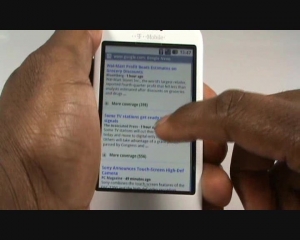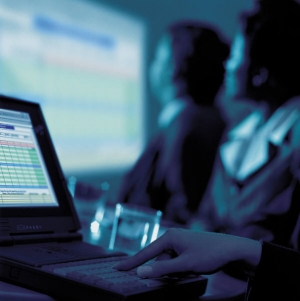KES 2010 will tell the story of lives in the transformation of digital generation. The lives of Digital natives are getting smarter, greener, and becoming three dimensional. Their code is all about efficiency, availability, and transparency. Most visitors come to KES 2010 with preconceived notions of the smart life, and use the show floor to further expand their imagination. Let's peak in on some of their stories and stroll the KES 2010 floor to find products that match their scenarios!
Mr. Kim's work starts with Remote access BI

Mr. Kim got a message on his way to work via his smart phone that the periodic analysis report had arrived. The report contained the results of analysis on the company's sales for the first half of the year. What was lacking was the projection of sales for the second half of the year. Mr. Kim had to prepare for his upcoming presentation as soon as he arrived at work, so he put off the analysis and went right to the meeting room.
As you can see, Mr. Kim can get important information from his smart phone by accessing the company's Business Intelligence (BI) system anytime, anywhere. Sometimes he takes advantage of having remote access to the BI system by doing the analysis work on his smart phone. Mr. Kim's company learned about the remote access BI system by way of a recommendation from the CEO of company 'A', President Kang. The events that turned President Kang in to a remote access BI 'evangelist' are the stuff of legends in the BI field. The full story is related below.
President Kang was on a business trip to Southeast Asia when he got the bad news from Korea during global financial crisis. He heard that the company's loan request at their bank was in jeopardy. The loan was needed in order to purchase raw materials for their production facilities. To make matters worse, he had just signed a supply contract with an overseas buyer. If the company was unable to secure the funding there would be no raw materials and the production facility would not be able to supply customers with the products which were currently on order. Not only would they fail to make the sale, but they would also incur hefty contract cancellation penalty charges.
President Kang made an urgent call to the loan officer at the bank to get the details regarding the status of the loan application. The loan officer apologized, but said there had been rumors that Kang's company had been experiencing serious problems with liquidity, therefore the bank had decided reject the company's request for a loan. The worst case scenario had come to fruition.

Since taking over the Chief Executive role, President Kang had been abroad for extended periods, representing the company at meetings with major foreign customers. He had been frustrated with his inability to remain informed about day to day situations that would impact the company at home. When crucial decisions had to be made, based on information that was sometimes days old, he wasn't prepared to choose the right path. The situation had become almost unbearable at the point when he got the news from the bank. Then he remember an article he had read in an airline magazine about Business Intelligence (BI) tools helping companies to make better informed decisions.
Business Intelligence refers to a sophisticated database combined with data mining tools that together provide customized reports, based on any data that is collected. When the BI solution is maintained in a cloud computing environment that allows for remote access, and the user has a smart phone with Internet access, then location and timezone no longer matter. With a smart phone, all of the company information, with a myriad of parsing options, either on the fly or canned, the traveling executive is out of excuses if he makes a poor decision.
President Kang decided on the spot to investigate the implementation of a remotely accessible BI solution. After learning some more about the various options, he came to the conclusion that, for the health of his company and his own sanity, remote access BI was something that neither could survive without.
President Kang's company adopted the remote access BI system at the beginning of this year. From that point forward it was possible to have a firm grasp on the current situation of the company, based on real-time information to make high value decisions. Remote access BI via smart phone whenever, wherever made all the difference.
Subsequent to the implementation, an event occurred which confirmed the decision to invest in the new system was a good one. One day, Kang's company became became an unwilling subject of stories in the press. Reports of defective products being shipped by the company made headline news. At the time President Kang was enjoying a vacation with his family on on Jeju island. When he got the news of what was happening back home, he immediately checked production an QA reports for the subject product runs from the BI system using his smart phone. It was clear from the data that been generated only hours before that the nature of the problem was being exaggerated. He contacted the editor of the newspaper that was reporting the story and shared what he had learned. The editor told him that if he could substantiate his claim with solid evidence, then the paper would print a retraction. President Kang sent reports and video of QA that was performed on the suspect lots. It was clear that there was nothing wrong with the parts when they left the factor. The company posted a rebuttal to the story on their website and initiated an investigation before the close of business the same day. Their quick action had abated further negative reports.
Not long after, the company's investigation revealed that the parts had been damaged in transit, due to a negligent carrier. The shipping operator took responsibility for the problem, compensated President Kang's company and issued a press release absolving company 'A' of any wrong doing. The quick and trustworthy action of company 'A' became the talk of town. In the aftermath of the situation, President Kang knew that prompt action based on solid information and swift decision-making through knowlege gaind from having remote access to the BI system with his smart phone rescued the company from the possible negative outcome and the crisis was averted. From that day ever after, President Kang became an 'evangelist', advocating remote access BI via smart phone for all.
The moment when Ms. Lee's shines

Ms. Lee has a wireless power transmitter. It collects ambient electricity from nearby sources, such as electric waves or wireless transmitting towers. She uses it to charge her smart phone when the battery gets low. In most countries of the world these days electricity is collected using wireless transmitter, without ever plugging in the power cord.
The ultimate beauty of smart phones is when they are used in group settings, rather than in individual pursuits. Ms. Lee's was traveling on business to Busan the other day. On the way, she realized that she wasn't fully satisfied with the presentation she had prepared. So she edited it using her smart phone on the way down. When she arrived at the conference site, she transmitted the modified data directly from her smart phone to the digital TV in the meeting room. The client was very impressed and the presentation was a resounding success. Ms. Lee has joined the ranks of the true believers and become an 'evangelist' of mobile convergence.
Mr. Kim's breezes into the presentation using a smart phone

Mr. Kim just got to the meeting room and started prepping for his presentation about the current situation on customer care. He felt sweaty and hot from coming into the room in such a rush. Through the automatic resource scanning function of his smart phone, he found the air-conditioner on the ceiling of the room and controlled it with his phone. There were only a few minutes left until the meeting was scheduled to start, but he calmly controlled the projector using his phone's M2M network function. He was able to complete the preparation for the presentation by simply bringing up the data he had stored the night before in his smart phone to the screen through the projector.
Under CoAP (central control center established under IETF standards), Mr. Kim's company analyzes the patterns of staff movements to control their environment. For example, the sensor can turn the light off at an employee's desk space when they leave the area. The lights of the office can also be turned off with the sensor as the workers leave the office in the evening.
Mr. Park's User Review on the Mobile Card
Mr. Park and his client were walking down the street near a restaurant in the COEX, looking for a place to eat. Mr. Park was using an augmented reality application on his smart phone to help them decide where to go. The restaurant in their vicinity was one of the members of mobile card "S", and it recognized that Mr. Park, who was in the possession of the S card, was nearby. A system at the restaurant sent information about the new menu and a free beverage coupon to Mr. Parks's smart phone. Mr. Park and his client decided to take the restaurant up on their offer. After Mr. Park finished his satisfying dinner, he checked the bill through the POS (point of sales) feature in his smart phone.
As he clicked the page, all of Mr. Park's applicable credit and debit cards appeared on the screen in order of recommendation. On top was the S card, which provided a 10% discount on meals over 20,000 won. When he chose the card, the transaction was simply completed. As he left the restaurant, he was sent a text message with a coupon which said thanks for the first visit. Also included with the message was a free-dessert coupon for his next visit. Mr. Park was pleasantly surprised by so many benefits from the mobile card "S" that he was issued only a few days before.
Mr. Lee never gets lost
After a long presentation, Mr. Lee started to work on the analysis of their rival, company "B". He was so focused on his work that he forgot about his lunch appointment with a client. A call from the client shook him out of his reverie and he rushed out of his office to make the appointment at the COEX. He left in such a hurry that he forgot the directions to his destination. Mr. Lee turned on the GPS-based navigator on his smart phone to figure out where to go, but it only showed him that he was in the COEX. As time went by, Mr. Lee got more and more nervous. How could he get to the meeting place on time
Fortunately Mr. Lee remembered that he had recently installed an application that used augmented reality. With that app he could be guided to the place of the meeting. The application that he downloaded, named COEXAR (COEX Augmented Reality), came from the Appstore for free. It was different from the navigator that came with the smart phone, in that it could work inside the COEX to give him specific information about his location and surroundings. COEXAR also provided information about nearby stores, their business hours, and even sent coupons for the restaurant where Mr. Lee was meeting his client. Life doesn't get much better.


